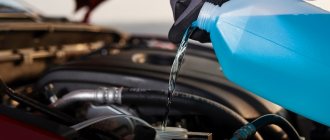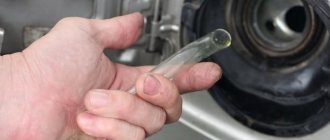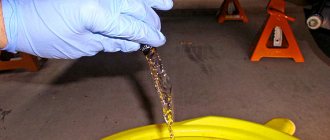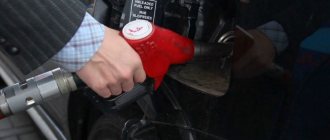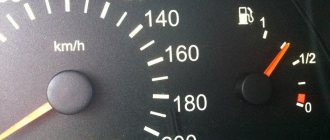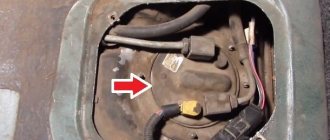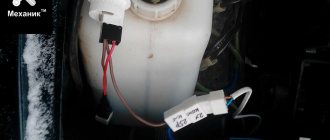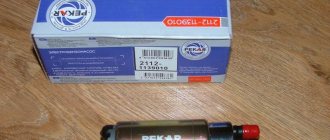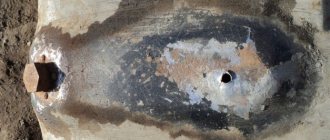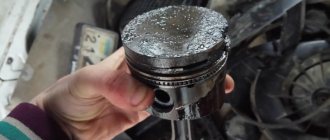| Options | Fuel tank volume, l |
| 1.5 MT Basic | 43 |
| 1.6MT0 | 43 |
| 1.6 MT Basic | 43 |
| 1.6MT0 | 43 |
| 1.6MT0 | 43 |
| 1.6MT2 | 43 |
| 1.6MT0 | 43 |
| 1.6MT0 | 43 |
| 1.6MT2 | 43 |
| 1.6MT0 | 43 |
| 1.6MT1 | 43 |
| 1.6 MT 211440-24 | 43 |
| 1.6 MT 211440-26 | 43 |
How to drain gasoline from a VAZ 2114: necessity and solution to the problem
Motorists whose cars have been damaged by low-quality gasoline need to do everything possible to get their car back into working condition. How to drain gasoline from a VAZ 2114? What do you need to know about this difficult process?
Why drain gasoline?
It is necessary to drain gasoline if the car owner previously filled the tank with low-quality fuel. To eliminate any negative consequences associated with the destructive influence of such gasoline, it is necessary to drain all the remaining fuel in the tank.
Poor fuel quality is far from the only reason why motorists waste gasoline. It happens that at gas stations there are cases of topping up diesel fuel. It’s good if the car owner finds out about this quickly enough. Otherwise, he will have to flush not only the tank, but also the fuel pump.
Some car enthusiasts dump fuel in order to make big money from it. For example, a driver can refuel a car in another country at a low price, and then return to Russia and sell the fuel, making a profit. Naturally, we are not considering this option, but are talking only about those cases when it is necessary to drain gasoline in order for your car to continue to serve you faithfully.
Is it possible to drain gasoline from a VAZ 2114 with your own hands?
You can drain gasoline without involving specialists. Every car enthusiast can do this. All you need is to strictly follow the instructions presented below.
Particular care should be taken because gasoline is highly flammable and can cause serious damage not only to your car, but also to your health. It is advisable to carry out all gas tank cleaning procedures outdoors.
You will also need the help of another person. This is due to safety precautions. If a fire occurs, his help may prove invaluable.
How to drain gasoline from a VAZ 2114 tank
On the 2114 model, pumping out fuel is not as easy as it might seem at first glance. The VAZ 2114 is a modern car, so it has a special design for the tank filler neck.
It will not be possible to pump out gasoline even with the help of a dropper tube. It is for this reason that many ways have been invented to drain gasoline from this model. We will consider those that are suitable for ordinary car enthusiasts.
Ways to drain gasoline
In some situations it is necessary to completely dry the tank. The reason for this is that condensation may form in the tank. It is able to settle on the walls, and then mix with gasoline and settle to the very bottom.
This can pose a serious threat to the fuel system, so if too much sediment accumulates, the sediment must be removed somehow. To do this, you can remove the tank. This will not be easy to do. Some car enthusiasts who have never removed the tank will have to spend a couple of hours. In addition, to remove the tank you will need a lift or at least an inspection hole.
If you think that you can cope with this difficult procedure, then first of all you should remove the filler pipe from the tank. In this case, there will be very little mixture of gasoline and condensate left in it. It should only be drained when the gas tank is completely removed.
- Once the tank is removed, you will need to give it a good flush with clean gasoline. Instead of gasoline, you can use a mixture of alcohol and gasoline.
- Once this is done, all you have to do is dry out the gas tank and reinstall it on the car. This method guarantees complete removal of any traces of fuel.
Draining gasoline without having to remove the tank
If you do not have the time and energy to dismantle the gas tank, a standard fuel pump can help you. In the 2114 model it can be found in the tank itself.
- To do this, you will need to find a hose that has a suitable diameter so that it can be placed on a special fuel rail fixture.
- After this, you will need to unscrew the nipple from the fitting, and then put on the hose and apply 12 V to the fuel pump.
- Now you can start draining the fuel into a previously prepared container.
Removing and installing the tank filler neck on a VAZ 2110
So, the first thing you need to do is remove the rear right wheel and first jack up the car to make it easier to carry out all the repairs. After this, unscrew the clamp bolt that secures the hose and pipe.
Now we go up a little higher and unscrew the neck fastening nut using a 13 mm wrench. This is clearly shown in the photo below.
And another clamp is located above. There you will need a key for 10.
And remove the clamp, putting it aside so as not to lose it. Next, open the gas tank flap and remove the rubber casing.
And now you can carefully move the filling pipe down to bring it to a more convenient position.
And now all that remains is to disconnect the hose from the top of the pipe, which is shown in the photo. We loosen the clamp that tightens this thin hose.
And after trying a little, we remove the hose from the tube:
Now the neck is almost completely freed, and all that remains is to disconnect it from the hose from below, the clamp of which we unscrewed at the very beginning.
After which we remove it without any problems. The end result is shown in the photo below.
The price of a new neck (filler pipe) of a gas tank on a VAZ 2110 is about 1000 rubles, but the same version can be bought at a disassembly site for half the price. Installation occurs in reverse order.
Method 1. Removing the tank
The first way to drain gasoline from a VAZ 2114 involves removing the fuel tank. The procedure may take several hours, but it will completely remove the fuel from the container. It is advisable to carry out the work on a lift or inspection pit. The algorithm for removing the tank and draining the fuel is as follows:
- Reduce the pressure in the vehicle's fuel line.
- Disconnect the fuel line fittings from the fuel filter.
- Loosen the clamps and disconnect the gravity valve and filler pipe hoses.
- Using the filler hose, drain the remaining fuel from the gas tank.
- Loosen the hose that bleeds air from the fuel tank and disconnect it. It is recommended to cover the openings of the liquid container with rags.
- Place a stand under the tank for support.
- Using a 13mm socket wrench, unscrew the fuel tank fasteners and remove it.
- Remove any remaining fuel from the container and rinse it with water and gasoline.
- Put the tank in place.
Fuel tank design
The main function of a fuel tank is to store a certain amount of fuel. At the same time, everything must be organized so that the likelihood of a fire hazard is minimized.
On VAZ cars the fuel tank is located under the rear seats. Due to this placement, in the event of serious accidents and car overturns, the tank in most cases remains undamaged. VAZ fuel tanks are made of leaded steel sheets. Thanks to a thin layer of lead that protects against corrosion, the service life of the tank is significantly increased. The outside of the fuel tank is covered with dark enamel.
The fuel tank, covered with dark enamel, is reliably protected from corrosion
The fuel storage volume of the VAZ 2108 and other similar models is 43 liters. This takes into account the reserve, but it is not recommended to fill the tank to the brim. You should always leave a free volume of about four liters. It is especially important to do this in the summer, since the fuel expands as the temperature rises. If the tank is filled to the brim, then after swelling it may simply burst. The volume of the VAZ gas tank is designed in such a way that the autonomous mileage is enough for 500 kilometers, and this is considered a normal road segment in modern conditions.
The tank is securely fixed to the car body using flexible and durable plate-type clamps. Rubber gaskets must be placed under the clamps to ensure a tighter connection.
The tank mounting plates are very flexible and durable
Gasoline is poured through the neck on the right (in the direction of travel) rear side of the body. It is closed with a screw cap.
The neck of the VAZ 2115 tank is closed with a tight lid
Main elements of the fuel tank
The neck is connected to the tank cavity through the filler hose. The other two tubes are integrated with a seven-liter separator installed outside the tank and designed to capture gasoline vapors. As a result of wear, the separator may split along the seam and gasoline will begin to leak out. It can be replaced without dismantling the tank. Moreover, you can temporarily cover the separator seam with a gasoline-resistant sealant.
The separator tank holds seven liters of fuel
In order not to remove the separator (it is necessary to dismantle the bumper and filler pipe), experienced car owners simply disconnect the hoses of the element and cut it out with metal scissors. In place of the separator, a fine fuel injection filter is installed, which performs similar functions.
Instead of a separator, you can install a fine fuel filter
Some separators are equipped with a double-acting valve to minimize fuel leakage. The valve admits and releases gasoline vapor. Once in the tank, the vapors condense and thereby reduce fuel consumption.
The fuel system of the VAZ 2112 car is quite simple
The tank of VAZ cars produced after 2000 is equipped with a fuel level sensor (FLS), which regulates the amount of gasoline in the tank and sends data to the electronic control unit (ECU). The sensor is fixed through a rubber gasket and can be easily removed through the rear seat.
The fuel level sensor is installed on all VAZ models produced after 2000
Method 2. Using a fuel pump.
You can drain fuel from a VAZ 2114 (injector) without removing the gas tank using the car’s fuel pump. This method is much simpler, but more dangerous. There is a high probability of damage to the fuel pump. Work algorithm:
- Select a hose of such diameter that it can be put on the fuel rail.
- Unscrew the nipple installed in the fitting and put on the hose.
- Ensure that the fuel pump receives 12 V.
- Pour the liquid into a container prepared in advance.
This method should be used as a last resort, as it is unsafe for the car’s fuel system. In addition, it will not allow all the fuel to be completely drained from the tank.
Flushing the gas tank of a VAZ 2110
Flushing the gas tank is an operation that must be performed at least once every two years, regardless of whether the tank is in good condition or not. Over time, contaminants accumulate in the tank, which can subsequently impair the performance of both the fuel pump and other components of the fuel system.
Tank flushing sequence
To clean the gas tank, you must perform the following manipulations:
- The gas tank is removed from the VAZ 2110 as described above. After this, you need to drain all remaining gasoline from the gas tank.
- Now you need to rinse the tank. To do this, any detergent is poured into it. Even household dishwashing liquid diluted in water will do.
- After filling the liquid, the tank must be allowed to stand for at least half an hour.
- After this time, the washing liquid is drained and the tank is rinsed with clean water.
Method 4. Drain through the neck with a pump.
There is another method of draining gasoline from the “fourteenth” tank. It requires skill and does not allow you to completely remove low-quality gasoline. To perform the operation, you will need a container for fuel, a hose of sufficient length and a pump. Instead of a pump, you can use a regular household vacuum cleaner. Algorithm of actions:
- Unscrew the cap and insert the hose into the tank.
- Check how much gasoline is in the tank. To do this, it is recommended to use a stick or insert a hose and then remove it. This will let you know the level.
- To pump out fuel, insert the hose as deeply as possible.
- Connect the hose to the pump or vacuum cleaner. You can use a pear. Some car enthusiasts try to suck out fuel with their mouths. It is not recommended to do this. This is very dangerous for your health! There is a high risk of accidentally ingesting gasoline, which can cause severe poisoning.
- Make sure that the hose is bent and looks like the letter S.
- Turn on the pump and turn it off abruptly.
- Direct the hose into a prepared container to drain the fuel. This must be done very quickly so as not to spill flammable liquid on the ground.
All methods presented in the article can effectively remove low-quality gasoline. But you should use the second method only when all the others, for one reason or another, turn out to be unavailable. And in order to have to drain fuel less often, you need to carefully select gas stations and use only large chain gas stations. There the risk of deception is much less. When setting off on a long journey, you should first check the location of such gas stations along the route.
How can you drain gasoline from a VAZ-2114
At least once in his practice, any car enthusiast has been faced with the need to drain gasoline from the car’s tank.
Often such a procedure is extremely necessary if, for example, low-quality fuel was poured. It is impossible in principle to eliminate its negative impact on the power plant in any other way.
In reality there are many more reasons. Sometimes an unfortunate mistake happens at a gas station and the tank is filled with diesel instead of gasoline. Fortunately, such troubles do not happen too often.
Of course, nothing bad will happen if the “non-native” fuel does not get into the power unit. Troubles can be avoided if the diesel fuel is removed immediately. But when the problem is not noticed, and the car drives for some time on such a wild mixture, you will have to start washing all the elements of the fuel system and first of all you need to clean:
It is possible that the filters will also need to be replaced.
Few difficulties arise for owners of old cars - here the problem is solved with the help of a hose or a suitable tube diameter. It is simply inserted into the filler hole and, after pulling up the fuel with your mouth, it is poured into a substitute container. The principle of communicating vessels works for you here.
Major damage to the gas tank
When using a fuel tank for a long time, situations arise that require repair. First of all this:
- holes and cracks resulting from mechanical stress and corrosion;
- clogging of pipes and hoses directly connected to the tank;
- damage to the connecting seam at the junction of the tank halves.
Small cracks are usually sealed. This is a rather labor-intensive procedure, but the functionality of the tank can be completely restored. In case of major damage or holes, the tank is replaced with a new one. Dirt gets into the hoses along with low-quality fuel. In this case, the mesh through which gasoline enters the tank may become clogged. Therefore, it must be periodically washed and changed. In addition, you should only refuel at proven gas stations and do not abuse additives to reduce fuel consumption. The weakest point of the tank is the seam, which is constantly subjected to severe stress. This can be avoided if the tank is made in one piece. The fuel tank can also fail due to deformation of the neck, formation of dents after an accident, separation of partitions inside the tank, etc.
Features of the VAZ-2114
This model already belongs to more modern vehicles, in which the design features of the filler neck simply do not allow the use of the time-tested method described above. It is not possible to insert even a thin tube removed from the IV into it. In this regard, it will be necessary to use other, somewhat less effective methods that make it possible to remove fuel, if not completely, then almost to the very bottom.
- dismantling the tank;
- using a fuel pump;
- directly through the hole located in the cabin.
In a VAZ-2114 injector, it is unfortunately impossible to do this using a return line - this method is only suitable for older cars.
Replacing the gas tank on a VAZ 2110
To successfully replace the tank on a VAZ 2110, we will need the following tools and materials:
- new gas tank for VAZ 2110;
- open-end wrenches - set;
- flat screwdriver.
Sequence of operations when replacing a tank
The success of the event lies in the scrupulous implementation of the following actions:
- The VAZ 2110 is installed on an overpass or on an inspection hole. The handbrake is applied.
- In the cabin, the floor covering moves back, under which there is a fuel pump hatch. The power wires are disconnected from this pump and a pair of fuel pipes are unscrewed. This is done using a 17mm open-end wrench.
Power wires and fuel pipes are removed from the VAZ 2110 fuel pump
The clamp holding the VAZ 2110 filler tube is loosened and the tube is removed
The hose on the neck of the VAZ 2110 is loosened with a socket head by 8 and then moved to the side
Two mounting bolts holding the bars on which the tank of the VAZ 2110 hangs
The slats on which the VAZ 2110 tank hangs bend down
The VAZ 2110 gas tank needs to be tilted down a little to get to the last hose
The thinnest hose is removed from the VAZ 2110 gas tank manually
The VAZ 2110 gas tank was dismantled and removed from under the car
First option
You will need to completely remove the gas tank in situations where you need to not just drain the gasoline, but literally drain the tank.
For example, this is necessary to remove condensate that has accumulated there, which settles on the walls for a long time and gradually flows to the bottom. When a critical amount of it accumulates, the engine begins to work improperly. Dismantling the tank as a whole can be done without difficulty, but this procedure takes quite a lot of time - up to three hours, depending on experience and the availability of equipment. You will need a lift or, in extreme cases, an inspection ramp or pit.
Before removal, the container will need to be emptied of fuel. It will be great if you guess the moment when the gas just runs out. Otherwise, it is necessary to remove the filler hose directly from the gas tank and pump out excess fuel through the hole. As a result, several liters of fuel and condensate itself will remain at the bottom.
The dismantled tank must be thoroughly washed with pure gasoline or a mixture of gasoline and alcohol. Next, it remains to be dried and returned to the place determined by the designers.
It is worth pointing out that the method described above remains the only one that allows you to completely remove fuel from the gas tank.
Second option
It involves the use of a fuel pump installed in the VAZ-2114 directly in the tank. The disadvantage of this method is the risk of damaging the above-mentioned unit responsible for pumping gasoline.
Draining this way is quick. Here you will need to perform the following procedure:
- find a fitting on the fuel rail designed to reduce pressure;
- unscrew the nipple from it;
- put on a hose of suitable diameter;
- power the pump with 12 Volts;
- drain the gasoline into a canister or other suitable container.
This option, as noted earlier, is the fastest, but also the most traumatic for the car. In particular, the following can be damaged (clogged):
- coarse filter;
- the pump itself;
- fuel line
Gas tank vapor recovery system
In almost every modern car, the gas tank has a built-in ventilation system (otherwise called a vapor recovery system).
It includes elements such as:
- separator;
- connecting tubes;
- two way valve.
The main purpose of this system is to maintain stable pressure inside the tank and capture vapors formed in it during strong shaking, vibration, or in hot weather, when the fuel inside begins to expand and evaporate. The absence of such ventilation could lead to the fact that the gas tank, under the influence of excess vapor pressure, would simply swell and become deformed.
The fuel vapor recovery system operates as follows:
- when heated or vibrating, gasoline vapors are formed in the tank;
- due to their volatility, they rise up and fall inside two drainage tubes running from the tank to the separator;
- getting inside the separator, they condense, turning into drops of liquid, and flow back into the gas tank;
- excess vapors that do not have time to condense (for example, in very hot weather) enter the two-way valve from the separator and are discharged into the atmosphere.
In cars with an injector, the tank ventilation system works on a similar principle with the only difference that instead of a two-way valve, it has an adsorber (absorber) of vapors installed, which accumulates them and, at the command of the ECU, releases them into the engine for afterburning. This avoids intentional leakage of fuel into the environment.
